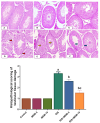Memantine abrogates testicular dysfunction induced by risperidone in rats with a potential role of ERK1/2-Nrf2-caspase-3 signaling pathway
- PMID: 40234489
- PMCID: PMC12000432
- DOI: 10.1038/s41598-025-94760-1
Memantine abrogates testicular dysfunction induced by risperidone in rats with a potential role of ERK1/2-Nrf2-caspase-3 signaling pathway
Abstract
Psychosis is usually a substantial global burden with a prevalence of 0.4-2%. On the other hand, 50 million people are suffering from dementia, with dementia-related psychosis affecting approximately 25% of them. The current experiment aimed to investigate the effect of the anti-dementia drug memantine (MEM) on testicular damage and insulin resistance induced by the chronic administration of risperidone (RIS) in rats. Six groups of Wistar albino rats were designated as follows: control, MEM-5 (rats received MEM at 5 mg/kg/day, orally, for 4 weeks), MEM-10 (rats received MEM at 10 mg/kg/day, orally, for 4 weeks), RIS (rats were administered RIS at 2.5 mg/kg/day, orally, for 4 weeks), RIS + MEM-5 (rats received MEM at 5 mg/kg/day, orally, co-administered with RIS as in the RIS group for 4 weeks), and RIS + MEM-10 (rats received MEM at 10 mg/kg/day, orally, co-administered with RIS as in the RIS group for 4 weeks). The duration of the study was 28 days. Serum testosterone, resistin, and adiponectin concentrations were determined. The homeostatic model assessment of insulin resistance (HOMA-IR) was also evaluated. Oxidative stress, inflammatory markers, and immunoblotting of ERK1/2, and Nrf2 were quantified in testicular tissue together with histopathological evaluation and a caspase-3 immunohistochemical study. MEM co-administration increased adiponectin, serum testosterone, GSH, SOD, CAT, and Nrf2 expression while decreasing HOMA-IR, resistin, MDA, NOx, ERK1/2, IL-6, TNF-α, NFĸB, and caspase-3 expression. Furthermore, MEM ameliorated all measured parameters and histopathological changes that occurred in the RIS group in a dose-dependent manner. The primary outcomes were attained by attenuating oxidative stress, inflammation, and apoptosis in the testis caused by chronic RIS administration via regulation of the ERK1/2-Nrf2 signaling pathway. Targeting the ERK1/2-Nrf2 pathway is a potential strategy for addressing testicular injury.
Keywords: Anti-dementia; Antipsychotics; Memantine; Reproductive toxicity; Risperidone.
© 2025. The Author(s).
Conflict of interest statement
Declarations. Competing interests: The authors declare no competing interests. Ethical approval: The study was approved by the institutional ethical committee (Faculty of Medicine, Minia University Egypt, Approval No.28:3/2021).
Figures







Similar articles
-
Ameliorating diabetes-induced testicular dysfunction by modulating PKC/Nrf2/Bcl-2 signaling: Protective role of sulbutiamine.Biofactors. 2024 Jul-Aug;50(4):845-862. doi: 10.1002/biof.2046. Epub 2024 Feb 12. Biofactors. 2024. PMID: 38344831
-
Role of Nrf2/HO-1, PPAR-γ, and cytoglobin signals in the pathogenesis of methotrexate-induced testicular intoxication in rats and the protective effect of diacerein.Naunyn Schmiedebergs Arch Pharmacol. 2024 Jun;397(6):4235-4246. doi: 10.1007/s00210-023-02876-w. Epub 2023 Dec 7. Naunyn Schmiedebergs Arch Pharmacol. 2024. PMID: 38060042
-
Testicular toxicity in cisplatin-treated Wistar rats is mitigated by Daflon and associated with modulation of Nrf2/HO-1 and TLR4/NF-kB signaling.J Trace Elem Med Biol. 2024 Sep;85:127489. doi: 10.1016/j.jtemb.2024.127489. Epub 2024 Jun 26. J Trace Elem Med Biol. 2024. PMID: 38943836
-
Ginkgo biloba extract (EGb 761) mitigates methotrexate-induced testicular insult in rats: Targeting oxidative stress, energy deficit and spermatogenesis.Biomed Pharmacother. 2021 Nov;143:112201. doi: 10.1016/j.biopha.2021.112201. Epub 2021 Sep 21. Biomed Pharmacother. 2021. PMID: 34560547
-
Carvedilol induces the antiapoptotic proteins Nrf2 and Bcl2 and inhibits cellular apoptosis in aluminum-induced testicular toxicity in male Wistar rats.Biomed Pharmacother. 2021 Jul;139:111594. doi: 10.1016/j.biopha.2021.111594. Epub 2021 Apr 18. Biomed Pharmacother. 2021. PMID: 33878623
Cited by
-
Modulating platelet-activating factor by rupatadine attenuates gentamicin-induced nephrotoxicity in rats via NF-κB/caspase-3 and Nrf2/HO-1 signaling cascades.Naunyn Schmiedebergs Arch Pharmacol. 2025 Jun 4. doi: 10.1007/s00210-025-04327-0. Online ahead of print. Naunyn Schmiedebergs Arch Pharmacol. 2025. PMID: 40464943
References
-
- Tendilla-Beltrán, H. et al. Neuroplasticity and inflammatory alterations in the nucleus accumbens are corrected after risperidone treatment in a schizophrenia-related developmental model in rats. Schizophr. Res.235 17–28 (2021). - PubMed
-
- Urban, A. E. & Cubała, W. J. Therapeutic drug monitoring of atypical antipsychotics. Psychiatr. Pol.51(6), 1059–1077 (2017). - PubMed
MeSH terms
Substances
LinkOut - more resources
Full Text Sources
Medical
Research Materials
Miscellaneous

